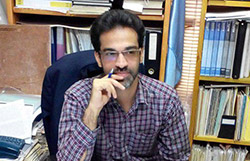Oral history of photos and photography needed
Jafar Golshan Roughani (PhD)
Translated by M. B. Khoshnevisan
2019-1-22
Since the early years of the rule of Nssereddin Shah, the King of Qajar (1895-1945) till today, many Iranian photographers have taken numerous photos each of which puts on display the lifestyle of the Iranians and what have happened to them.
The displaying of goodness and wickedness, sadness and happiness, ugliness and beauty, women and men, children and elderly people, national characters and government officials, villagers and townspeople, the rich and the poor, tradesmen and business owners, the displaced persons, beggars and delinquents, wars and clashes, peace and reconciliation, screams and protests, and hundreds of other issues have been taken in the frame of photographers and millions of photos have been produced.
Now, after the passing of those years, we look at the photos, and after a proper pause on each photo, we feel that we wish to know more about their subject and content. We wish that its photographer was alive and available so that we could ask him or her more about how such a photo was created and emerged, and receive extensive and accurate answers.

He or she talked about how he or she has lived and started the photography career? How has he or she taken photos? How and when has he or she learnt the knowledge and techniques of photography? How has he or she attended in the photography scenes in view of the considered subjects? What has been in his or her mind while taking a photo? What was he or she thinking about? How has he or she interpreted and analyzed the time of the occurrence of the incidents and events that according to it, he or she has decided to take photos. How have the interests of his or her photography been emerged and why has he or she taken photos from such a subject?
Has he or she thought about the result of taking photos for this scene or other ones; what do others think about him or her and what do and will say about his or her photos? Has he or she photographed by understanding the conditions of the time and such thinking, or has done this merely for recording a moment of the history according to his or her will, mentality and interests and has not been important the next judgements for him or her? Has he or she thought about publishing them in written and visual media such as the publications and sites, TV and the internet, bulletins and brochures and so on?
Has he or she thought about the point that he or she has frozen a moment of history and made it enduring and eternal through photographing? Has he or she thought about such issues basically? Has he or she known that like some historians and owners of memories and daily notes, he or she has recorded hundreds of words and images for Iranian contemporary history through every single of his or her photo, and adds it to the treasure of written and visual historical data of Iranian human in the contemporary world? Has he or she known that his or her photos can narrate part of the Iranian lifestyle at that time?
All of these are the questions that every viewer can regret them by looking at the photos; we wish it was his or her photo and asked such unanswered questions and tens of other questions that we had in mind. On this basis, it is desirable that the present and alive photographers who have photographed various manifestations of the Iranian life in different times and places are interviewed knowingly in order to acquire the oral history of their life and activities and in other activity, demands them useful answers about every single of the photos they have taken.
Number of Visits: 4578








The latest
Most visited
A Statistical Glance at the Oral History Archive of Iran
The Oral History Weekly, an electronic periodical that commenced its regular publication in November 2010, now stands on the threshold of releasing its 700th issue. Published every Wednesday, the newsletter consolidates all content posted on the Oral History website over the preceding week and circulates it to more than 850 subscribers via email. This report—drawing upon statistical data from content published on ...A Memory of an Army Aviation Pilot
I was taking a nap in my office when the door opened and a soldier entered the room. I got up from my chair and after arranging my clothes, I prepared to hear the soldier's news. After saluting, he said, "Captain, the commander has business with you." And with this, he paid military respect and left the room.Monafeghin: A New Deception
July-August 1989Following the discussions around the asylum of Iraqi prisoners of war in Iran during peace negotiations, the Iraqi side, not wanting to fall behind, launched their own campaign to offer asylum. At the outset, they attempted to attract prisoners by making grand promises ...
Supports from Guilds and Bazaars peaple
Memoirs of Haj Hossein FathiOur base of operations had become the Saheb al-Zaman Mosque in the Kamp-Lou neighborhood of Ahvaz. With the assistance of Brother Khani and his companions, we began preparing hot meals and sending them to the frontlines. We ourselves, along with several fellow merchants from the bazaar, entered the conflict zone, bringing warm clothing, ...


